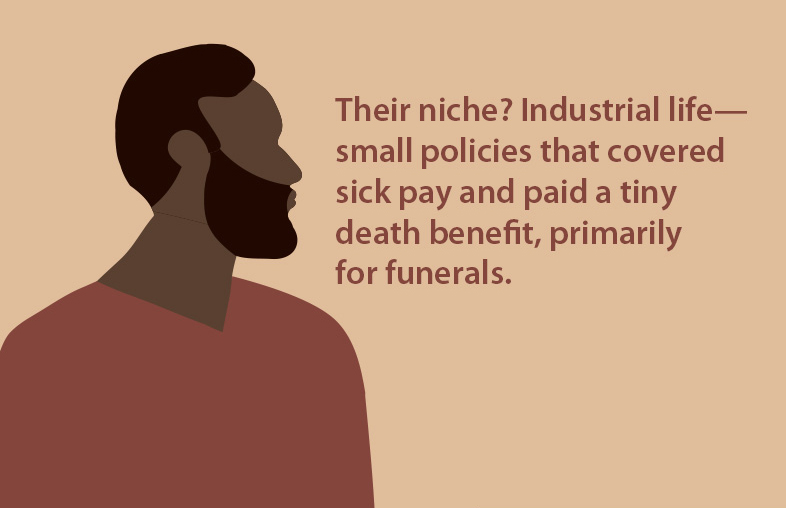Black life insurers served their constituencies in good times and bad
By James Lynch
Though few exist today, Black life insurance companies were a prominent part of Black life for nearly a century. In an era when most life insurers routinely discriminated, they provided financial protection, invested in their communities, and were a widely publicized source of pride.

Black life insurers grew out of the benevolent society movement of the mid- to late 1800s. These and other church-based societies usually operated on a subscription basis. If a person was injured and needed financial help, the society often needed to raise additional money—essentially passing the hat.
It was an unstable structure. Insurance companies had the financial strength to keep their promises. Life insurer assets grew 12,000% between 1850 and 1900.
At first, major insurers charged Black and white insureds the same rates. Around 1890, their financial results showed how discrimination of all forms shifted inordinate risk onto Black insureds, who worked the most dangerous jobs, were shunted into the worst housing, and were denied proper medical care. Of course, they tended to die sooner.
Companies quickly adjusted rates. Black insureds could pay 50% more for the same coverage as white policyholders, or they could pay the same rate for two-thirds the coverage.
A few states—Massachusetts, for example—banned race as a rating variable. Most companies responded by refusing to write policies for Black citizens at all.
Only one major insurer, Metropolitan Life, bucked the trend. Even it refused to hire Black workers.
While those attitudes and actions are repulsive, they created what amounted to protectionism for companies that would write Black policies. Companies formed by Black businesspeople could hire the competent Black underwriters, agents, and actuaries that white companies shunned—and sell to the Black customers the white companies refused.
Early companies included the North Carolina Mutual and Provident Association, begun in 1898, the Afro-American Insurance Company (1901) and the Atlanta Mutual Insurance Company (1905). Major firms formed later, including North Carolina Mutual and Golden State Mutual.
The International Association of Black Actuaries has an excellent annotated interactive timeline about Black history and the evolution of the U.S. insurance industry.
Their niche? Industrial life—small policies that covered sick pay and paid a tiny death benefit, primarily for funerals. Premiums were a few cents a week, collected by an agent who had a weekly route, similar to what a milkman or newspaper carrier might have.
We can follow the success of Black insurers through the reports of the National Negro Insurance Association, formed by 14 companies in 1921. The association’s actions were widely disseminated in the Black press for decades.
By 1929, 27 insurers had $291 million in force. They suffered but survived the Great Depression, outlasting the Black banking industry, which struggled (as did all banks). By 1946, only 12 Black-owned banks remained, but the insurance association had 45 members writing $700 million in force on 9 million policies.
The insurers held high status in their realm. For Black newspapers, they were good copy (as well as prominent advertisers).

The insurance association’s meetings were regularly covered nationwide. And they garnered considerable local attention. In 1945, New York Mayor Fiorello LaGuardia addressed the meeting, as did top politicians elsewhere should it come to their town. The travels and tribulations of insurance leaders got coverage that resembles modern celebrity news today.
Black-owned insurance companies went into a slow decline after World War II. White insurers began to write more Black business. White companies began hiring away the best Black agents, and Black insurers (like most insurers) had trouble attracting talent.
The industrial life model was outmoded in a thriving economy that was beginning to share at least a little of its prosperity with minorities. Starting in the 1940s, white insurers were growing their group life business.
It was hard for Black insurers to pivot. The new products would attract different types of customers, which would mean they would require different actuarial analysis to arrive at pricing.
Lingering discrimination may have been at work, too. With industrial life, the purchasing decision is made by the person being insured. With group life, the purchasing decision is made by an executive in the organization sponsoring the program. In the 1950s, that executive was quite likely to be white—and to favor a white insurer over a Black insurer, regardless of capitalization.
Black insurers did respond. They became the National Insurance Association in 1948, dropping the word “Negro.”
The action was more than symbolic. Ebony magazine editorialized: “Although the companies are still owned and managed by Negroes, they are truly not Negro any longer. They not only have white agents selling policies for them, but many whites are insured by the Negro firms.”
It didn’t work out that way. The odious protectionism was replaced with could be considered a one-way integration. White companies gained Black business and hired Black employees. But whites rarely bought from Black insurers, and few whites became their agents.
There are only a couple of Black firms left; several were absorbed by white insurers. In their heyday, they were a model of how insurers can do well by doing the right thing.
JAMES LYNCH, MAAA, FCAS, is a freelance writer.
SOURCES:
C.A. Spencer; “Black Benevolent Societies and the Development of Black Insurance Companies in Nineteenth Century Alabama”; Phylon, third quarter 1985; Vol. 46, No. 3; pp. 251-261.
Robert E. Weems, Jr.; “The Chicago Metropolitan Mutual Assurance Company: A Profile of a Black-Owned Enterprise,” Illinois Historical Journal, Vol. 86, No. 1 (Spring 1993); pp. 15-26.
“Insurance Men Form Association”; New Journal and Guide; Nov. 12, 1921; p. 1.
“Numerous Highlights To Feature Insurance Companies’ Meeting”; New York Age; July 14, 1945; p. 4.
“Ins. Companies Hard Hit By Depression”; Afro-American; May 30, 1931; p. 11.
Ben Price; “Leader of States’ Rights Party Gives Views on Racial Question”; (Washington, D.C.) Evening Star; June 15, 1950.
“Rogues, Riches and Race”; Ebony; December 1954; p. 62.
“Negro Insurances Worth 70 Million”; Los Angeles Sentinel; June 27, 1946; p. 24.





